Journalism Ethics: Analysis of Violations and Alternatives
VerifiedAdded on 2022/09/10
|7
|1839
|31
Essay
AI Summary
This essay critically examines ethical violations within the field of journalism, focusing on three distinct instances where the code of ethics was breached. The analysis begins with the Rolling Stone Magazine's publication of a fabricated story titled "Rape on Campus," highlighting the consequences of untruthful reporting and the magazine's failure to conduct sufficient research. The essay then addresses the ethical lapse of a Boston radio show host who made offensive remarks about a deceased baseball player, emphasizing the importance of respectful and sensitive communication. Finally, it discusses the Daily Beast's misidentification of suspects in the Quebec Islamic Cultural Center attack, underscoring the need for fairness, accuracy, and thorough investigation. In each case, the essay presents alternative actions that could have been taken to uphold ethical standards, emphasizing the significance of truthfulness, respect, and responsible reporting practices in journalism. The essay uses sources such as Christians et al., Mills et al., Nilsson, Peterlin & Peters, and Wilkins & Christians to support its claims. The assignment is contributed by a student to be published on the website Desklib. Desklib is a platform which provides all the necessary AI based study tools for students.
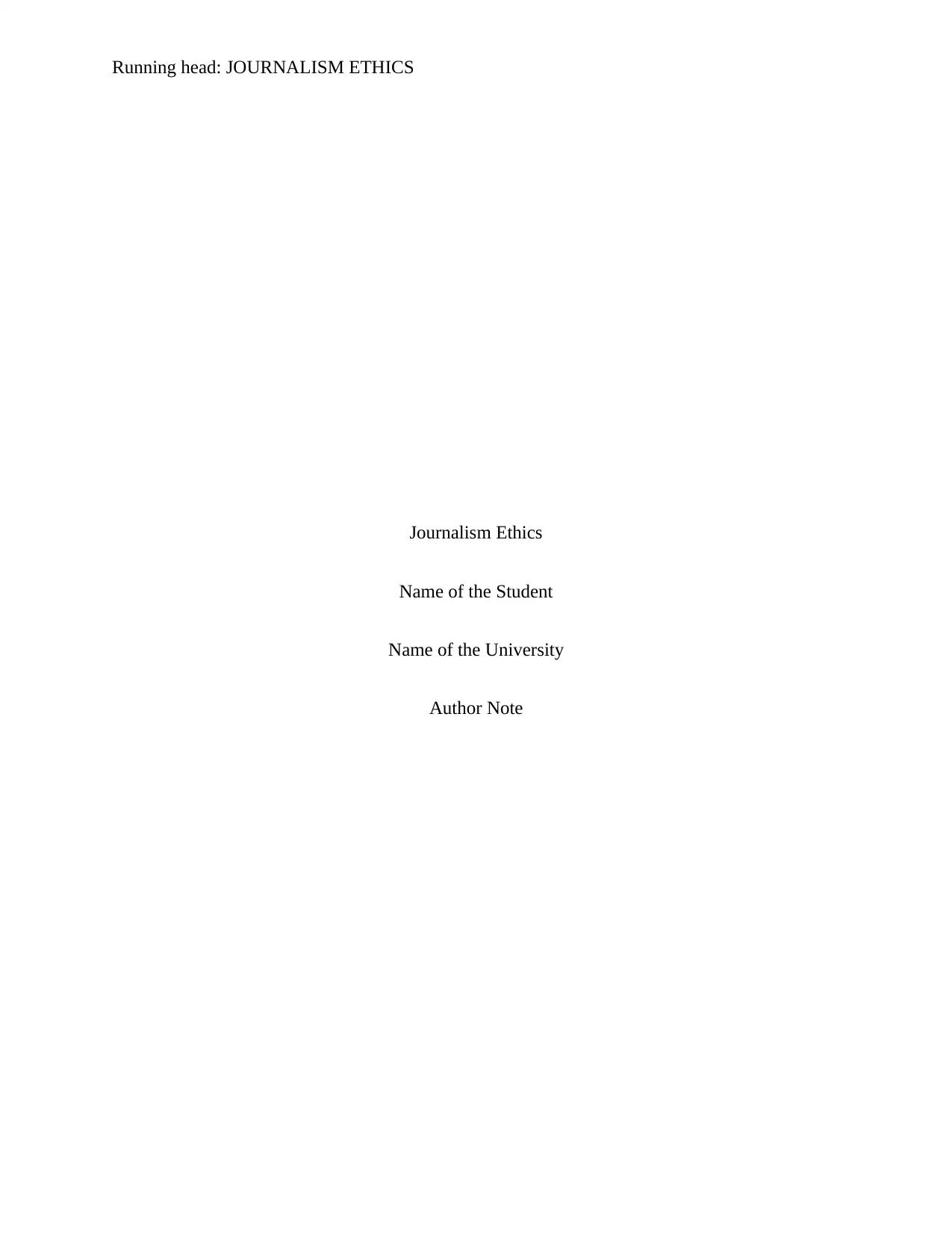
Running head: JOURNALISM ETHICS
Journalism Ethics
Name of the Student
Name of the University
Author Note
Journalism Ethics
Name of the Student
Name of the University
Author Note
Paraphrase This Document
Need a fresh take? Get an instant paraphrase of this document with our AI Paraphraser
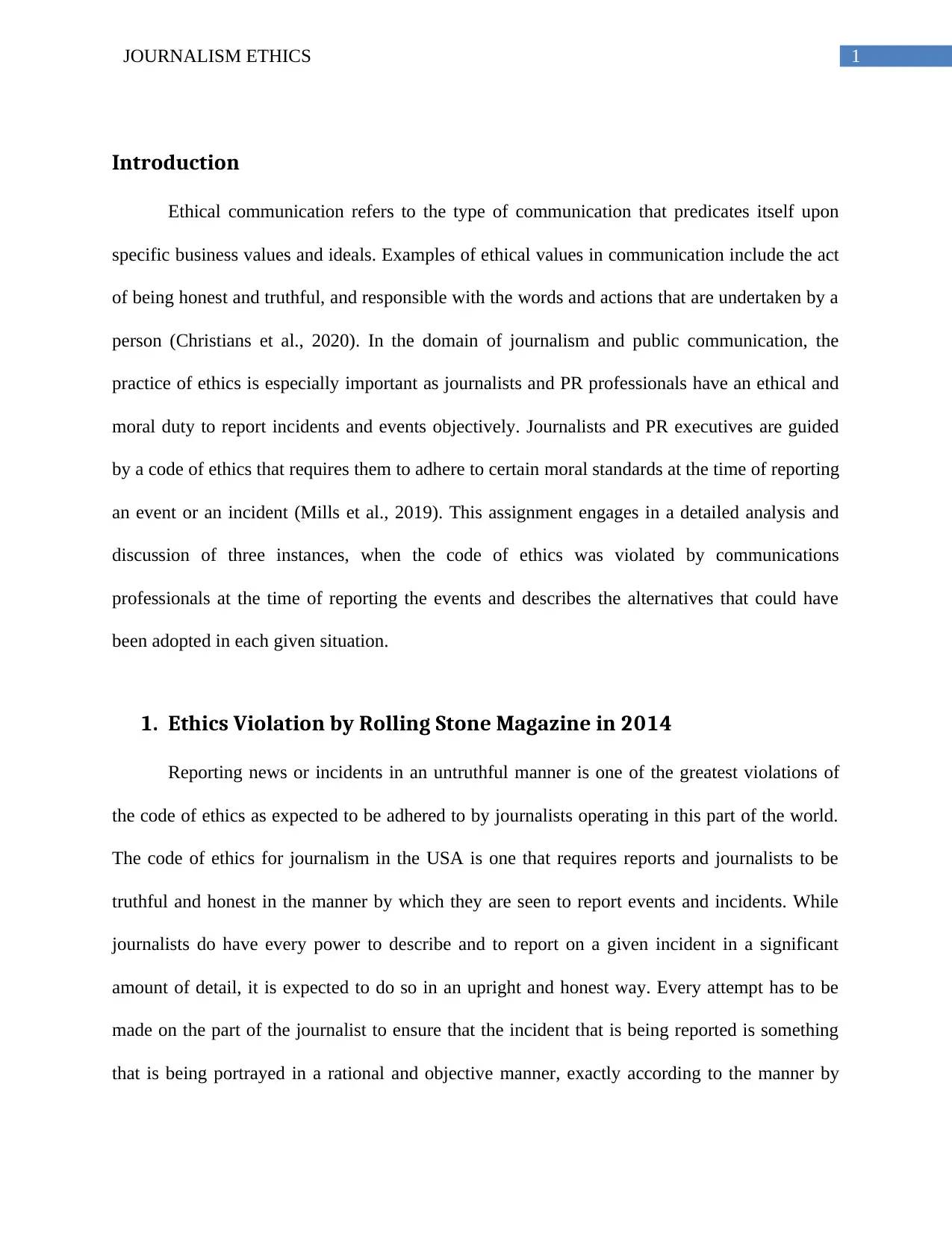
1JOURNALISM ETHICS
Introduction
Ethical communication refers to the type of communication that predicates itself upon
specific business values and ideals. Examples of ethical values in communication include the act
of being honest and truthful, and responsible with the words and actions that are undertaken by a
person (Christians et al., 2020). In the domain of journalism and public communication, the
practice of ethics is especially important as journalists and PR professionals have an ethical and
moral duty to report incidents and events objectively. Journalists and PR executives are guided
by a code of ethics that requires them to adhere to certain moral standards at the time of reporting
an event or an incident (Mills et al., 2019). This assignment engages in a detailed analysis and
discussion of three instances, when the code of ethics was violated by communications
professionals at the time of reporting the events and describes the alternatives that could have
been adopted in each given situation.
1. Ethics Violation by Rolling Stone Magazine in 2014
Reporting news or incidents in an untruthful manner is one of the greatest violations of
the code of ethics as expected to be adhered to by journalists operating in this part of the world.
The code of ethics for journalism in the USA is one that requires reports and journalists to be
truthful and honest in the manner by which they are seen to report events and incidents. While
journalists do have every power to describe and to report on a given incident in a significant
amount of detail, it is expected to do so in an upright and honest way. Every attempt has to be
made on the part of the journalist to ensure that the incident that is being reported is something
that is being portrayed in a rational and objective manner, exactly according to the manner by
Introduction
Ethical communication refers to the type of communication that predicates itself upon
specific business values and ideals. Examples of ethical values in communication include the act
of being honest and truthful, and responsible with the words and actions that are undertaken by a
person (Christians et al., 2020). In the domain of journalism and public communication, the
practice of ethics is especially important as journalists and PR professionals have an ethical and
moral duty to report incidents and events objectively. Journalists and PR executives are guided
by a code of ethics that requires them to adhere to certain moral standards at the time of reporting
an event or an incident (Mills et al., 2019). This assignment engages in a detailed analysis and
discussion of three instances, when the code of ethics was violated by communications
professionals at the time of reporting the events and describes the alternatives that could have
been adopted in each given situation.
1. Ethics Violation by Rolling Stone Magazine in 2014
Reporting news or incidents in an untruthful manner is one of the greatest violations of
the code of ethics as expected to be adhered to by journalists operating in this part of the world.
The code of ethics for journalism in the USA is one that requires reports and journalists to be
truthful and honest in the manner by which they are seen to report events and incidents. While
journalists do have every power to describe and to report on a given incident in a significant
amount of detail, it is expected to do so in an upright and honest way. Every attempt has to be
made on the part of the journalist to ensure that the incident that is being reported is something
that is being portrayed in a rational and objective manner, exactly according to the manner by
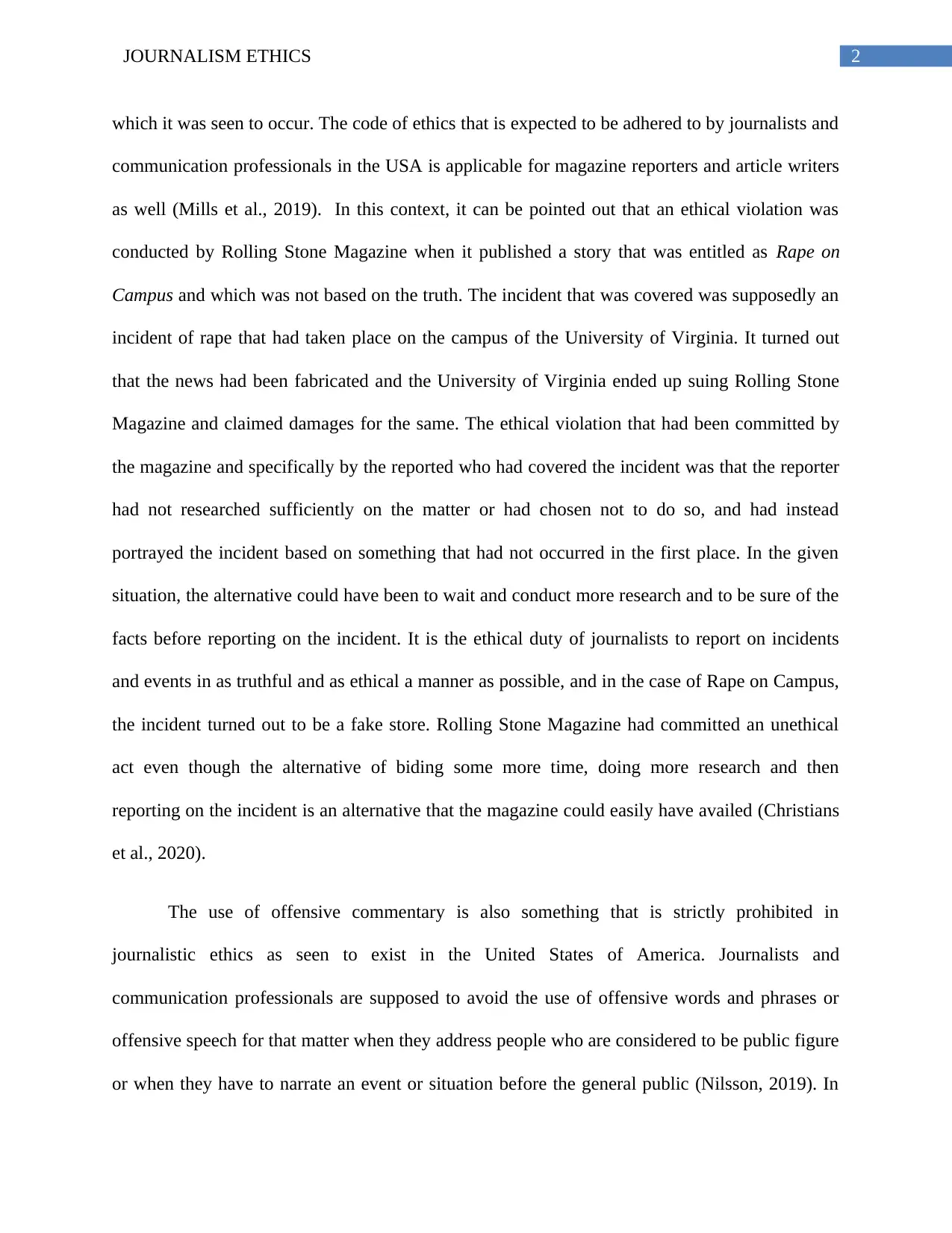
2JOURNALISM ETHICS
which it was seen to occur. The code of ethics that is expected to be adhered to by journalists and
communication professionals in the USA is applicable for magazine reporters and article writers
as well (Mills et al., 2019). In this context, it can be pointed out that an ethical violation was
conducted by Rolling Stone Magazine when it published a story that was entitled as Rape on
Campus and which was not based on the truth. The incident that was covered was supposedly an
incident of rape that had taken place on the campus of the University of Virginia. It turned out
that the news had been fabricated and the University of Virginia ended up suing Rolling Stone
Magazine and claimed damages for the same. The ethical violation that had been committed by
the magazine and specifically by the reported who had covered the incident was that the reporter
had not researched sufficiently on the matter or had chosen not to do so, and had instead
portrayed the incident based on something that had not occurred in the first place. In the given
situation, the alternative could have been to wait and conduct more research and to be sure of the
facts before reporting on the incident. It is the ethical duty of journalists to report on incidents
and events in as truthful and as ethical a manner as possible, and in the case of Rape on Campus,
the incident turned out to be a fake store. Rolling Stone Magazine had committed an unethical
act even though the alternative of biding some more time, doing more research and then
reporting on the incident is an alternative that the magazine could easily have availed (Christians
et al., 2020).
The use of offensive commentary is also something that is strictly prohibited in
journalistic ethics as seen to exist in the United States of America. Journalists and
communication professionals are supposed to avoid the use of offensive words and phrases or
offensive speech for that matter when they address people who are considered to be public figure
or when they have to narrate an event or situation before the general public (Nilsson, 2019). In
which it was seen to occur. The code of ethics that is expected to be adhered to by journalists and
communication professionals in the USA is applicable for magazine reporters and article writers
as well (Mills et al., 2019). In this context, it can be pointed out that an ethical violation was
conducted by Rolling Stone Magazine when it published a story that was entitled as Rape on
Campus and which was not based on the truth. The incident that was covered was supposedly an
incident of rape that had taken place on the campus of the University of Virginia. It turned out
that the news had been fabricated and the University of Virginia ended up suing Rolling Stone
Magazine and claimed damages for the same. The ethical violation that had been committed by
the magazine and specifically by the reported who had covered the incident was that the reporter
had not researched sufficiently on the matter or had chosen not to do so, and had instead
portrayed the incident based on something that had not occurred in the first place. In the given
situation, the alternative could have been to wait and conduct more research and to be sure of the
facts before reporting on the incident. It is the ethical duty of journalists to report on incidents
and events in as truthful and as ethical a manner as possible, and in the case of Rape on Campus,
the incident turned out to be a fake store. Rolling Stone Magazine had committed an unethical
act even though the alternative of biding some more time, doing more research and then
reporting on the incident is an alternative that the magazine could easily have availed (Christians
et al., 2020).
The use of offensive commentary is also something that is strictly prohibited in
journalistic ethics as seen to exist in the United States of America. Journalists and
communication professionals are supposed to avoid the use of offensive words and phrases or
offensive speech for that matter when they address people who are considered to be public figure
or when they have to narrate an event or situation before the general public (Nilsson, 2019). In
You're viewing a preview
Unlock full access by subscribing today!
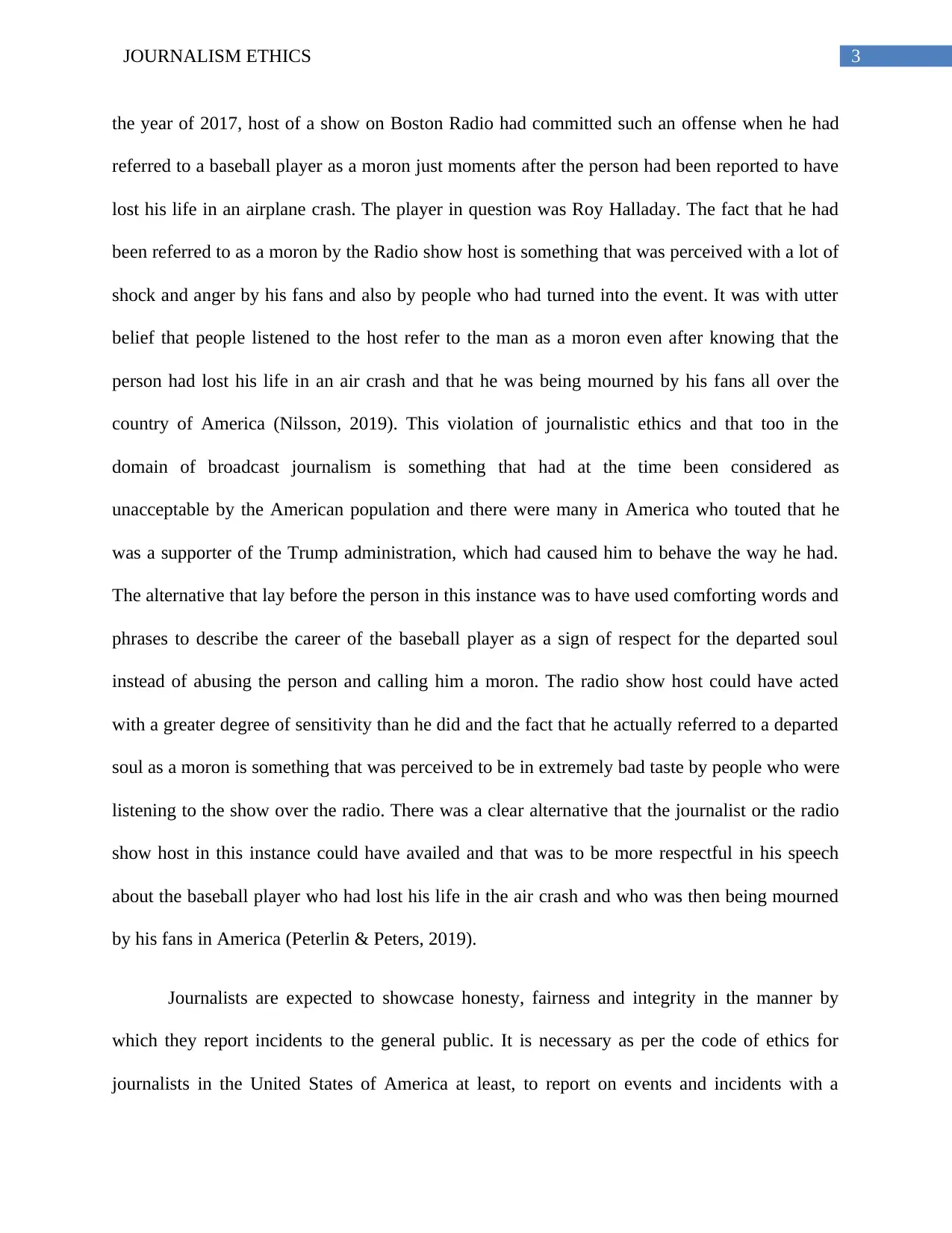
3JOURNALISM ETHICS
the year of 2017, host of a show on Boston Radio had committed such an offense when he had
referred to a baseball player as a moron just moments after the person had been reported to have
lost his life in an airplane crash. The player in question was Roy Halladay. The fact that he had
been referred to as a moron by the Radio show host is something that was perceived with a lot of
shock and anger by his fans and also by people who had turned into the event. It was with utter
belief that people listened to the host refer to the man as a moron even after knowing that the
person had lost his life in an air crash and that he was being mourned by his fans all over the
country of America (Nilsson, 2019). This violation of journalistic ethics and that too in the
domain of broadcast journalism is something that had at the time been considered as
unacceptable by the American population and there were many in America who touted that he
was a supporter of the Trump administration, which had caused him to behave the way he had.
The alternative that lay before the person in this instance was to have used comforting words and
phrases to describe the career of the baseball player as a sign of respect for the departed soul
instead of abusing the person and calling him a moron. The radio show host could have acted
with a greater degree of sensitivity than he did and the fact that he actually referred to a departed
soul as a moron is something that was perceived to be in extremely bad taste by people who were
listening to the show over the radio. There was a clear alternative that the journalist or the radio
show host in this instance could have availed and that was to be more respectful in his speech
about the baseball player who had lost his life in the air crash and who was then being mourned
by his fans in America (Peterlin & Peters, 2019).
Journalists are expected to showcase honesty, fairness and integrity in the manner by
which they report incidents to the general public. It is necessary as per the code of ethics for
journalists in the United States of America at least, to report on events and incidents with a
the year of 2017, host of a show on Boston Radio had committed such an offense when he had
referred to a baseball player as a moron just moments after the person had been reported to have
lost his life in an airplane crash. The player in question was Roy Halladay. The fact that he had
been referred to as a moron by the Radio show host is something that was perceived with a lot of
shock and anger by his fans and also by people who had turned into the event. It was with utter
belief that people listened to the host refer to the man as a moron even after knowing that the
person had lost his life in an air crash and that he was being mourned by his fans all over the
country of America (Nilsson, 2019). This violation of journalistic ethics and that too in the
domain of broadcast journalism is something that had at the time been considered as
unacceptable by the American population and there were many in America who touted that he
was a supporter of the Trump administration, which had caused him to behave the way he had.
The alternative that lay before the person in this instance was to have used comforting words and
phrases to describe the career of the baseball player as a sign of respect for the departed soul
instead of abusing the person and calling him a moron. The radio show host could have acted
with a greater degree of sensitivity than he did and the fact that he actually referred to a departed
soul as a moron is something that was perceived to be in extremely bad taste by people who were
listening to the show over the radio. There was a clear alternative that the journalist or the radio
show host in this instance could have availed and that was to be more respectful in his speech
about the baseball player who had lost his life in the air crash and who was then being mourned
by his fans in America (Peterlin & Peters, 2019).
Journalists are expected to showcase honesty, fairness and integrity in the manner by
which they report incidents to the general public. It is necessary as per the code of ethics for
journalists in the United States of America at least, to report on events and incidents with a
Paraphrase This Document
Need a fresh take? Get an instant paraphrase of this document with our AI Paraphraser
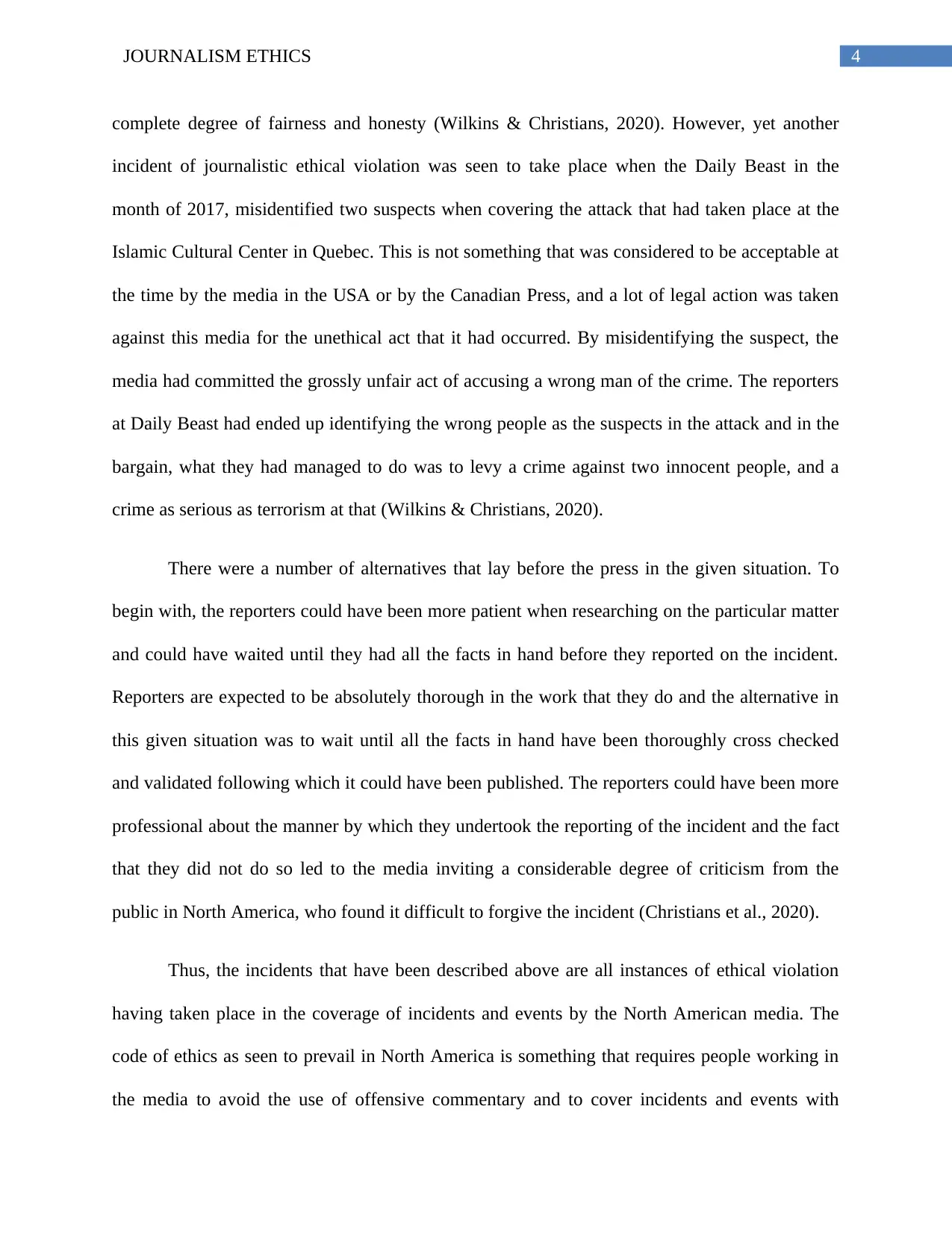
4JOURNALISM ETHICS
complete degree of fairness and honesty (Wilkins & Christians, 2020). However, yet another
incident of journalistic ethical violation was seen to take place when the Daily Beast in the
month of 2017, misidentified two suspects when covering the attack that had taken place at the
Islamic Cultural Center in Quebec. This is not something that was considered to be acceptable at
the time by the media in the USA or by the Canadian Press, and a lot of legal action was taken
against this media for the unethical act that it had occurred. By misidentifying the suspect, the
media had committed the grossly unfair act of accusing a wrong man of the crime. The reporters
at Daily Beast had ended up identifying the wrong people as the suspects in the attack and in the
bargain, what they had managed to do was to levy a crime against two innocent people, and a
crime as serious as terrorism at that (Wilkins & Christians, 2020).
There were a number of alternatives that lay before the press in the given situation. To
begin with, the reporters could have been more patient when researching on the particular matter
and could have waited until they had all the facts in hand before they reported on the incident.
Reporters are expected to be absolutely thorough in the work that they do and the alternative in
this given situation was to wait until all the facts in hand have been thoroughly cross checked
and validated following which it could have been published. The reporters could have been more
professional about the manner by which they undertook the reporting of the incident and the fact
that they did not do so led to the media inviting a considerable degree of criticism from the
public in North America, who found it difficult to forgive the incident (Christians et al., 2020).
Thus, the incidents that have been described above are all instances of ethical violation
having taken place in the coverage of incidents and events by the North American media. The
code of ethics as seen to prevail in North America is something that requires people working in
the media to avoid the use of offensive commentary and to cover incidents and events with
complete degree of fairness and honesty (Wilkins & Christians, 2020). However, yet another
incident of journalistic ethical violation was seen to take place when the Daily Beast in the
month of 2017, misidentified two suspects when covering the attack that had taken place at the
Islamic Cultural Center in Quebec. This is not something that was considered to be acceptable at
the time by the media in the USA or by the Canadian Press, and a lot of legal action was taken
against this media for the unethical act that it had occurred. By misidentifying the suspect, the
media had committed the grossly unfair act of accusing a wrong man of the crime. The reporters
at Daily Beast had ended up identifying the wrong people as the suspects in the attack and in the
bargain, what they had managed to do was to levy a crime against two innocent people, and a
crime as serious as terrorism at that (Wilkins & Christians, 2020).
There were a number of alternatives that lay before the press in the given situation. To
begin with, the reporters could have been more patient when researching on the particular matter
and could have waited until they had all the facts in hand before they reported on the incident.
Reporters are expected to be absolutely thorough in the work that they do and the alternative in
this given situation was to wait until all the facts in hand have been thoroughly cross checked
and validated following which it could have been published. The reporters could have been more
professional about the manner by which they undertook the reporting of the incident and the fact
that they did not do so led to the media inviting a considerable degree of criticism from the
public in North America, who found it difficult to forgive the incident (Christians et al., 2020).
Thus, the incidents that have been described above are all instances of ethical violation
having taken place in the coverage of incidents and events by the North American media. The
code of ethics as seen to prevail in North America is something that requires people working in
the media to avoid the use of offensive commentary and to cover incidents and events with
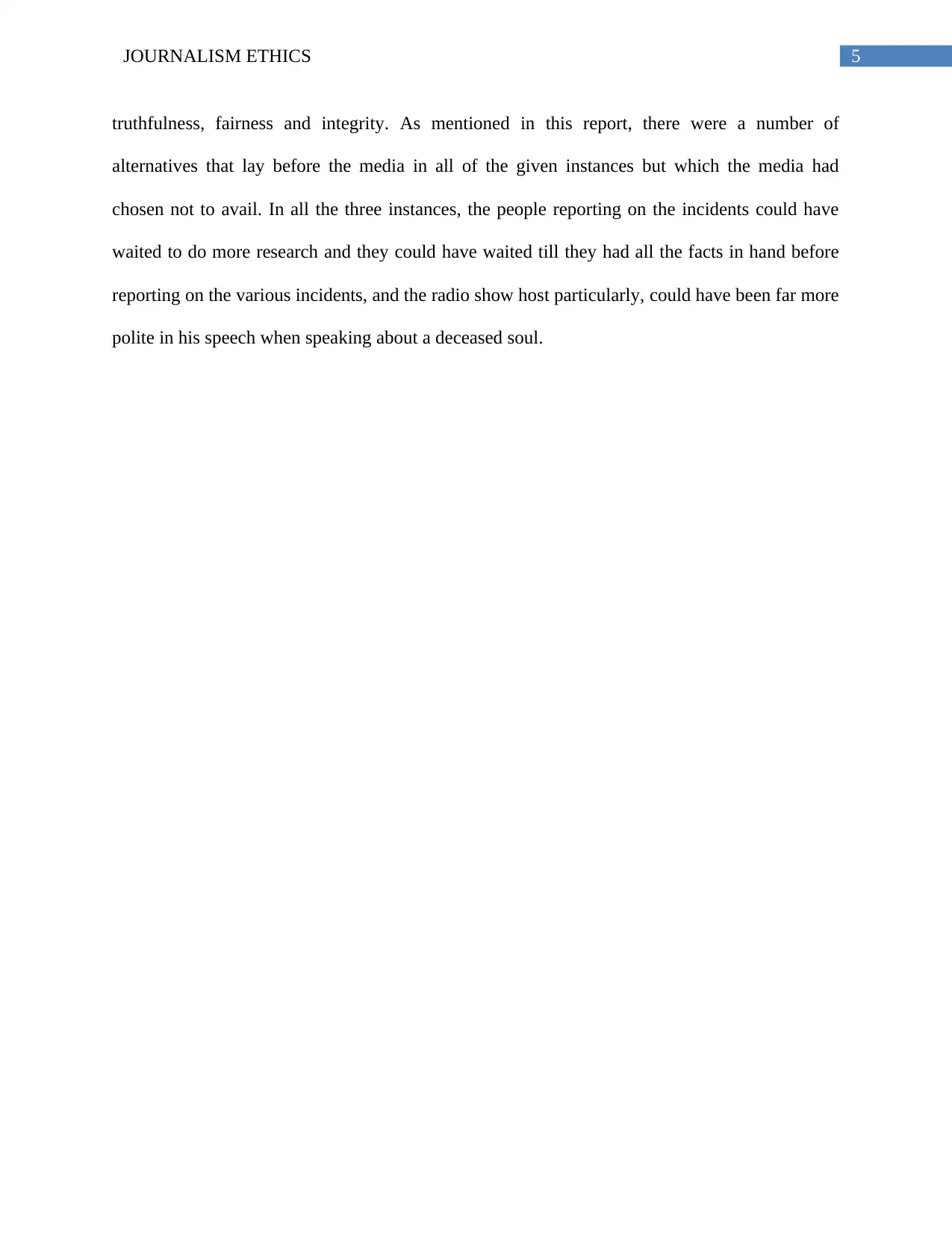
5JOURNALISM ETHICS
truthfulness, fairness and integrity. As mentioned in this report, there were a number of
alternatives that lay before the media in all of the given instances but which the media had
chosen not to avail. In all the three instances, the people reporting on the incidents could have
waited to do more research and they could have waited till they had all the facts in hand before
reporting on the various incidents, and the radio show host particularly, could have been far more
polite in his speech when speaking about a deceased soul.
truthfulness, fairness and integrity. As mentioned in this report, there were a number of
alternatives that lay before the media in all of the given instances but which the media had
chosen not to avail. In all the three instances, the people reporting on the incidents could have
waited to do more research and they could have waited till they had all the facts in hand before
reporting on the various incidents, and the radio show host particularly, could have been far more
polite in his speech when speaking about a deceased soul.
You're viewing a preview
Unlock full access by subscribing today!
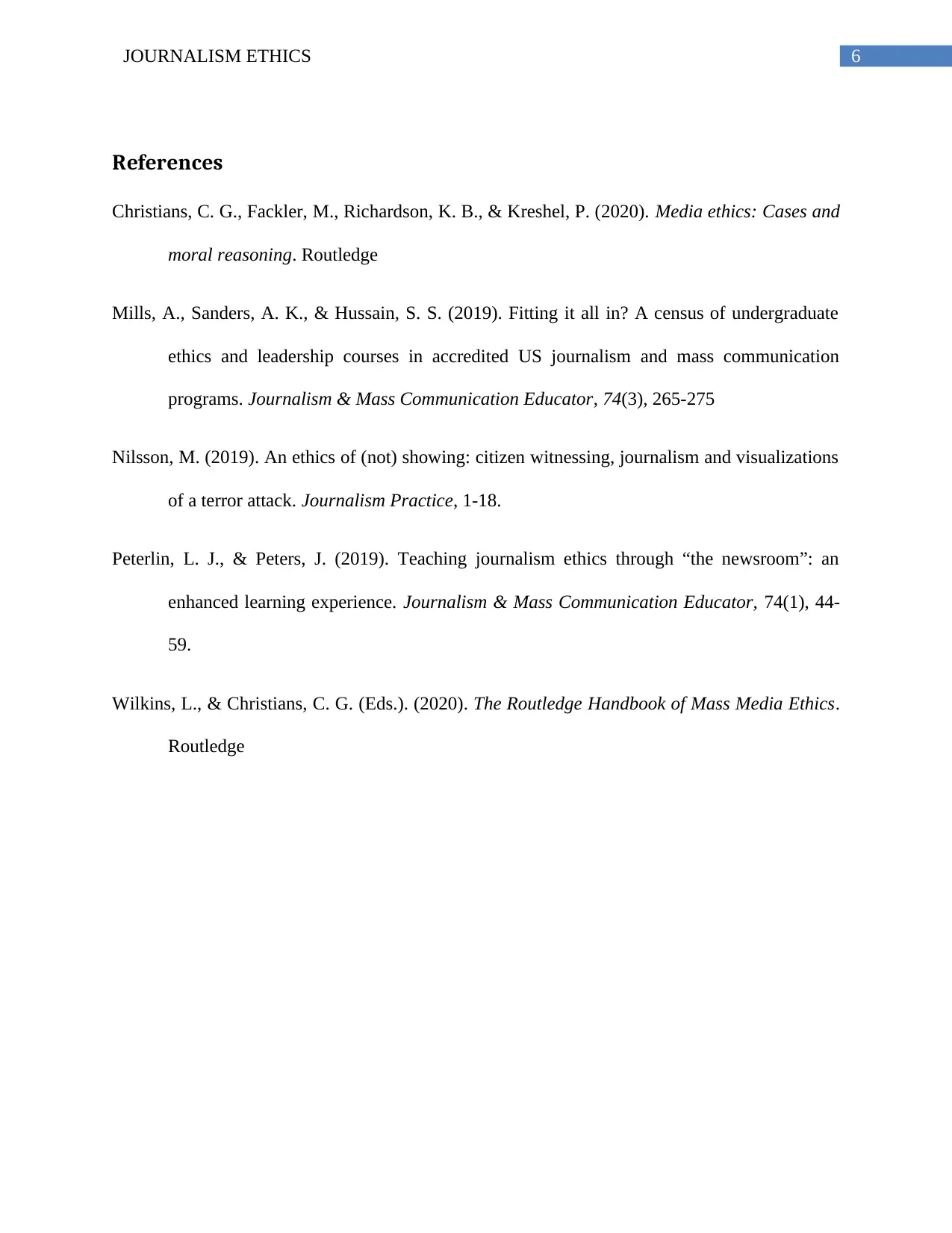
6JOURNALISM ETHICS
References
Christians, C. G., Fackler, M., Richardson, K. B., & Kreshel, P. (2020). Media ethics: Cases and
moral reasoning. Routledge
Mills, A., Sanders, A. K., & Hussain, S. S. (2019). Fitting it all in? A census of undergraduate
ethics and leadership courses in accredited US journalism and mass communication
programs. Journalism & Mass Communication Educator, 74(3), 265-275
Nilsson, M. (2019). An ethics of (not) showing: citizen witnessing, journalism and visualizations
of a terror attack. Journalism Practice, 1-18.
Peterlin, L. J., & Peters, J. (2019). Teaching journalism ethics through “the newsroom”: an
enhanced learning experience. Journalism & Mass Communication Educator, 74(1), 44-
59.
Wilkins, L., & Christians, C. G. (Eds.). (2020). The Routledge Handbook of Mass Media Ethics.
Routledge
References
Christians, C. G., Fackler, M., Richardson, K. B., & Kreshel, P. (2020). Media ethics: Cases and
moral reasoning. Routledge
Mills, A., Sanders, A. K., & Hussain, S. S. (2019). Fitting it all in? A census of undergraduate
ethics and leadership courses in accredited US journalism and mass communication
programs. Journalism & Mass Communication Educator, 74(3), 265-275
Nilsson, M. (2019). An ethics of (not) showing: citizen witnessing, journalism and visualizations
of a terror attack. Journalism Practice, 1-18.
Peterlin, L. J., & Peters, J. (2019). Teaching journalism ethics through “the newsroom”: an
enhanced learning experience. Journalism & Mass Communication Educator, 74(1), 44-
59.
Wilkins, L., & Christians, C. G. (Eds.). (2020). The Routledge Handbook of Mass Media Ethics.
Routledge
1 out of 7
Your All-in-One AI-Powered Toolkit for Academic Success.
+13062052269
info@desklib.com
Available 24*7 on WhatsApp / Email
![[object Object]](/_next/static/media/star-bottom.7253800d.svg)
Unlock your academic potential
© 2024 | Zucol Services PVT LTD | All rights reserved.